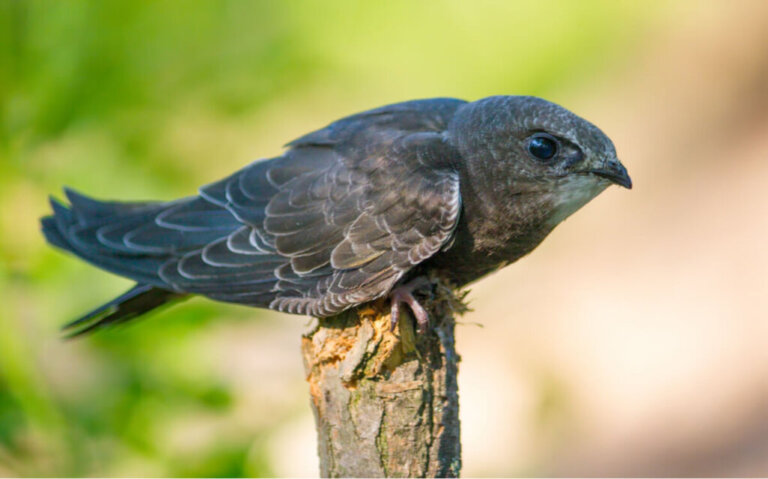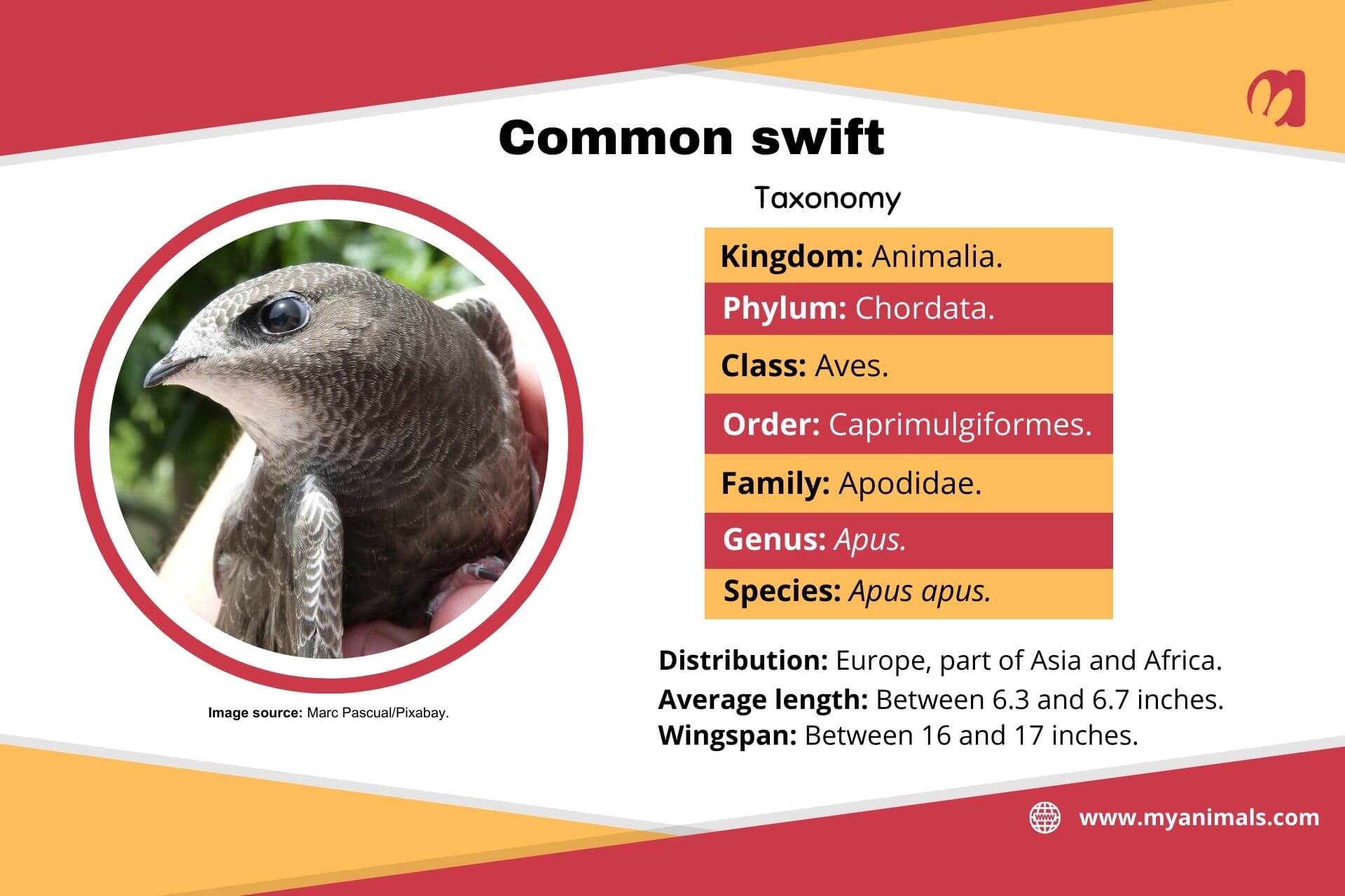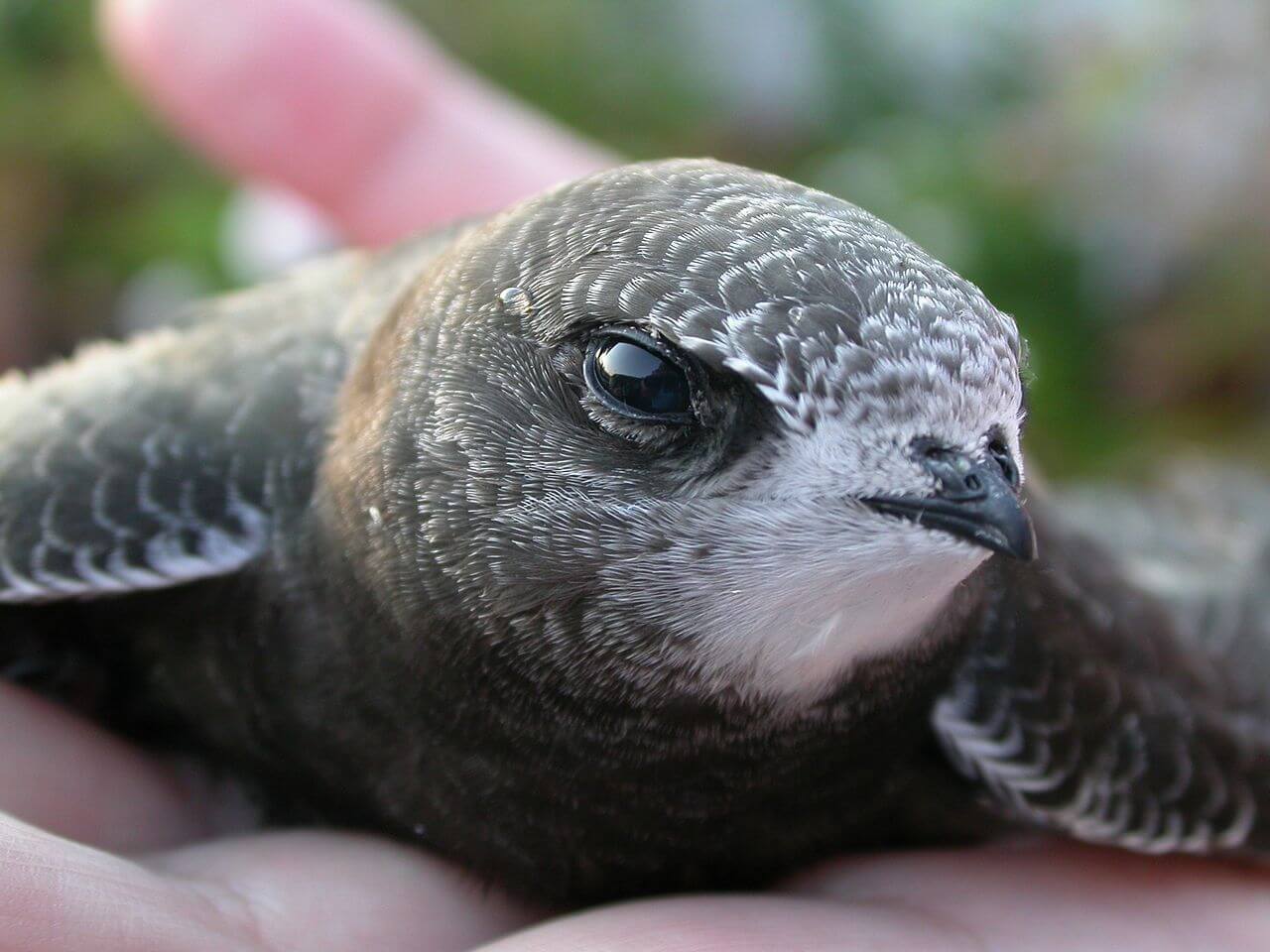Common Swift: The "Footless" Bird


Written and verified by the biologist Georgelin Espinoza Medina
There is great diversity among all bird species, not only in size, songs and colorations, but also in the different adaptations they present, either anatomically, physiologically or morphologically. There’s a particular bird, the common swift, the so-called “footless” bird, which arouses great interest, but why is this bird so special?
Its scientific name is Apus apus and it belongs to the group of Apodiformes or “footless” birds and to the family Apodidae. This is because its legs are very small. If you want to learn more about this species, stay with us until the end and discover all its secrets, since this particular characteristic isn’t the only interesting one.
Where do swifts live?

Common swifts or Apus apus live in Europe and part of Asia. They also spend the winter in Africa, in particular from the Democratic Republic of Congo and Tanzania to Zimbabwe and Mozambique.
The habitats are varied, as they are migratory birds that occupy different places throughout the year. According to the Royal Society for the Protection of Birds (RSPB), they traditionally live in crags, cliffs, caves, tree hollows, and nests made by other birds.
During the breeding period, they reside in temperate areas with trees for nesting and open spaces for foraging. After migration, they migrate to tropical regions on the African continent.
Characteristics of the common swift, the “footless” bird
This type of swift is a medium-sized bird. The Animal Diversity Web reports a length of 16 to 17 centimeters (around 6 to 7 inches), a wingspan of 42 to 48 centimeters (16-19 inches) and an average weight of 44.9 grams (under 2 oz). In addition, it’s noted for the following characteristics:
- Long, narrow wings
- A short beak
- A short tail with a smooth fork at the end.
The coloration of this bird is uniform, dark brown, but has a light white-cream-colored throat. Despite its brownish tone, when in flight it appears darker, almost black.
There is no sexual dimorphism between individuals, so males and females don’t differ in size and coloration. On the other hand, young swifts are usually darker than adults.
The most striking aspect of this type of bird is its legs, which are much shorter and feathered.
Although it could be thought that this is a disadvantage – because they aren’t observed perched on the ground – the truth is that they help them to cling on to vertical surfaces. These include chimneys and rock walls.
In general, the swift resembles a crossbow in shape and is often confused with a swallow. However, it has distinct differences, such as the following:
- A tendency to be larger and darker
- Flying at higher altitudes and for longer periods of time
- Longer wings
- Very small legs, which prevents it from perching on wires
- A less forked tail

Subspecies
There are two subspecies of common swifts. These are the following:
- Apus apus apus apus, the nominal subspecies
- Apus apus pekinensis
Song
The Spanish Ornithological Society (SEO BirdLife) describes the characteristic song of the common swift as a “short, monotonous, high-pitched squeak”. This sound is frequent in the evenings, during sunset, in the months with higher temperatures. It also details that there are differences in vocalizations between the sexes.
Migration and flight of the Apus apus
These birds are excellent fliers and spend much of their time in the air. They are also long-distance migrants, capable of making amazing journeys of around 3400 miles, twice a year. This is according to the Royal Society for the Protection of Birds (RSPB).
A study published in the journal Current Biology specifies that these animals can remain in uninterrupted flight for a long time. They do so for 10 months, while migrating to Africa or returning to their breeding habitat.
During these journeys, some take short breaks at night when they land to rest, but only for brief periods or even for an entire night. However, the record of inactivity is occasional, while the dynamism is greater in these months of migration, with more than 99% of flight time in the non-breeding period.
Feeding
The common swift is a bird of insectivorous habits. Feeding occurs in the air, while flying; it usually occurs at an altitude of 50 to 100 meters, but they can also be observed at lower or higher ranges.
An investigation of what they consume in the Mediterranean region, published in the journal Revue d’Ecologie in 2008, reveals that the diet is made up of arthropod animals. Among them, the following stand out:
- Homoptera
- Coleoptera
- Heteroptera
- Arachnids
It also states that they prefer winged and small insects.
Reproduction of the common swift
This apodiform is monogamous and reproduces once a year. The male chooses the nesting site, which can be a cliff, a cave, or a tree hollow. However, nowadays, he is more inclined to look for a place in a building.
If the female shows interest, she enters the area and the male caresses her chin with his beak. Mutual grooming may also occur, these behaviors mark the beginning of the pair’s bonding process.
An article on the breeding habits of swifts, notes that these birds “mate for life” and usually breed in the place where they live. Swifts may lay two to three eggs, two to three days apart. These are white and have an incubation time of 19 to 20 days. The young take 27 to 45 days to fledge, and both birds share breeding and nesting responsibilities.
An interesting aspect of this bird is that it can breed both in the air and in the nest.
Swifts are gregarious birds, that is, they live together in groups. This trait is also observed in the reproductive process. In fact, colonies can consist of up to 40 nests. These consist of canopies, built with various materials:
- Grasses
- Leaves
- Straws
- Flower petals
- Feathers
Conservation status of the common swift
This swift is not endangered. According to data provided by the International Union for Conservation of Nature (IUCN), it is listed as “Least Concern” in its global report.
However, in Europe, the same organization classifies this bird as a “Near Threatened” species. The assignment of this category responds to the fact that the population is in a declining state, despite its wide distribution. The main threat is the loss of nesting sites. In particular, the change and renovation of buildings, places that the bird uses to build its nests.
Special morphology and a life spent in the air
We have seen that the common swift is a striking animal, but not because of its colors or size, but because of its special morphology, and, in particular, its small legs. In addition, it is a bird that has adapted to aerial life, which allows it to spend a large part of the year in flight – up to 10 months – and even sleep in the air. Undoubtedly, a feat not achieved by any type of bird.
There is great diversity among all bird species, not only in size, songs and colorations, but also in the different adaptations they present, either anatomically, physiologically or morphologically. There’s a particular bird, the common swift, the so-called “footless” bird, which arouses great interest, but why is this bird so special?
Its scientific name is Apus apus and it belongs to the group of Apodiformes or “footless” birds and to the family Apodidae. This is because its legs are very small. If you want to learn more about this species, stay with us until the end and discover all its secrets, since this particular characteristic isn’t the only interesting one.
Where do swifts live?

Common swifts or Apus apus live in Europe and part of Asia. They also spend the winter in Africa, in particular from the Democratic Republic of Congo and Tanzania to Zimbabwe and Mozambique.
The habitats are varied, as they are migratory birds that occupy different places throughout the year. According to the Royal Society for the Protection of Birds (RSPB), they traditionally live in crags, cliffs, caves, tree hollows, and nests made by other birds.
During the breeding period, they reside in temperate areas with trees for nesting and open spaces for foraging. After migration, they migrate to tropical regions on the African continent.
Characteristics of the common swift, the “footless” bird
This type of swift is a medium-sized bird. The Animal Diversity Web reports a length of 16 to 17 centimeters (around 6 to 7 inches), a wingspan of 42 to 48 centimeters (16-19 inches) and an average weight of 44.9 grams (under 2 oz). In addition, it’s noted for the following characteristics:
- Long, narrow wings
- A short beak
- A short tail with a smooth fork at the end.
The coloration of this bird is uniform, dark brown, but has a light white-cream-colored throat. Despite its brownish tone, when in flight it appears darker, almost black.
There is no sexual dimorphism between individuals, so males and females don’t differ in size and coloration. On the other hand, young swifts are usually darker than adults.
The most striking aspect of this type of bird is its legs, which are much shorter and feathered.
Although it could be thought that this is a disadvantage – because they aren’t observed perched on the ground – the truth is that they help them to cling on to vertical surfaces. These include chimneys and rock walls.
In general, the swift resembles a crossbow in shape and is often confused with a swallow. However, it has distinct differences, such as the following:
- A tendency to be larger and darker
- Flying at higher altitudes and for longer periods of time
- Longer wings
- Very small legs, which prevents it from perching on wires
- A less forked tail

Subspecies
There are two subspecies of common swifts. These are the following:
- Apus apus apus apus, the nominal subspecies
- Apus apus pekinensis
Song
The Spanish Ornithological Society (SEO BirdLife) describes the characteristic song of the common swift as a “short, monotonous, high-pitched squeak”. This sound is frequent in the evenings, during sunset, in the months with higher temperatures. It also details that there are differences in vocalizations between the sexes.
Migration and flight of the Apus apus
These birds are excellent fliers and spend much of their time in the air. They are also long-distance migrants, capable of making amazing journeys of around 3400 miles, twice a year. This is according to the Royal Society for the Protection of Birds (RSPB).
A study published in the journal Current Biology specifies that these animals can remain in uninterrupted flight for a long time. They do so for 10 months, while migrating to Africa or returning to their breeding habitat.
During these journeys, some take short breaks at night when they land to rest, but only for brief periods or even for an entire night. However, the record of inactivity is occasional, while the dynamism is greater in these months of migration, with more than 99% of flight time in the non-breeding period.
Feeding
The common swift is a bird of insectivorous habits. Feeding occurs in the air, while flying; it usually occurs at an altitude of 50 to 100 meters, but they can also be observed at lower or higher ranges.
An investigation of what they consume in the Mediterranean region, published in the journal Revue d’Ecologie in 2008, reveals that the diet is made up of arthropod animals. Among them, the following stand out:
- Homoptera
- Coleoptera
- Heteroptera
- Arachnids
It also states that they prefer winged and small insects.
Reproduction of the common swift
This apodiform is monogamous and reproduces once a year. The male chooses the nesting site, which can be a cliff, a cave, or a tree hollow. However, nowadays, he is more inclined to look for a place in a building.
If the female shows interest, she enters the area and the male caresses her chin with his beak. Mutual grooming may also occur, these behaviors mark the beginning of the pair’s bonding process.
An article on the breeding habits of swifts, notes that these birds “mate for life” and usually breed in the place where they live. Swifts may lay two to three eggs, two to three days apart. These are white and have an incubation time of 19 to 20 days. The young take 27 to 45 days to fledge, and both birds share breeding and nesting responsibilities.
An interesting aspect of this bird is that it can breed both in the air and in the nest.
Swifts are gregarious birds, that is, they live together in groups. This trait is also observed in the reproductive process. In fact, colonies can consist of up to 40 nests. These consist of canopies, built with various materials:
- Grasses
- Leaves
- Straws
- Flower petals
- Feathers
Conservation status of the common swift
This swift is not endangered. According to data provided by the International Union for Conservation of Nature (IUCN), it is listed as “Least Concern” in its global report.
However, in Europe, the same organization classifies this bird as a “Near Threatened” species. The assignment of this category responds to the fact that the population is in a declining state, despite its wide distribution. The main threat is the loss of nesting sites. In particular, the change and renovation of buildings, places that the bird uses to build its nests.
Special morphology and a life spent in the air
We have seen that the common swift is a striking animal, but not because of its colors or size, but because of its special morphology, and, in particular, its small legs. In addition, it is a bird that has adapted to aerial life, which allows it to spend a large part of the year in flight – up to 10 months – and even sleep in the air. Undoubtedly, a feat not achieved by any type of bird.
All cited sources were thoroughly reviewed by our team to ensure their quality, reliability, currency, and validity. The bibliography of this article was considered reliable and of academic or scientific accuracy.
- BirdLife International. (2016). Apus apus. The IUCN Red List of Threatened Species 2016: e.T22686800A86111691. https://dx.doi.org/10.2305/IUCN.UK.2016-3.RLTS.T22686800A86111691.en. https://www.iucnredlist.org/species/22686800/86111691
- BirdLife International. (2021). Apus apus (Europe assessment). The IUCN Red List of Threatened Species 2021: e.T22686800A166220766. https://www.iucnredlist.org/species/22686800/166220766
- Gory, G. (2008). Diet of the Common Swift (Apus apus) in the Mediterranean region. Revue d Ecologie, 63(3), 251-260. https://www.researchgate.net/publication/289702416_Diet_of_the_Common_Swift_Apus_apus_in_the_Mediterranean_region
- Hedenstrom, A., Norevik., G., Warfringe, K., Andersson, A., Backman, J., & Akesson, S. (2016). Annual 10-Month Aerial Life Phase in the Common Swift Apus apus. Current Biology, 26(22), 3066-3070. https://www.cell.com/current-biology/fulltext/S0960-9822%2816%2931063-6
- Sociedad Española de Ornitología SEO/BirdLife. (s.f.). Vencejo común. Consultado el 07 de junio de 2023. https://seo.org/ave/vencejo-comun/
- The Royal Society for the Protection of Birds (s.f.). Distribution and migration. Consultado el 07 de junio de 2023.
https://www.rspb.org.uk/birds-and-wildlife/wildlife-guides/bird-a-z/swift/distribution-migration/ - The Royal Society for the Protection of Birds (s.f.). Swifts breeding and nesting habits. Consultado el 13 de junio de 2023. https://www.rspb.org.uk/birds-and-wildlife/wildlife-guides/bird-a-z/swift/breeding-nesting-habits/#:~:text=Swifts%20pair%20for%20life%2C%20meeting,all%20the%20nesting%20duties%20equally.
- The Royal Society for the Protection of Birds (s.f.). Swift. Consultado el 07 de junio de 2023. https://www.rspb.org.uk/birds-and-wildlife/wildlife-guides/bird-a-z/swift/
- The Royal Society for the Protection of Birds (s.f.). What do Swift eat? Consultado el 07 de junio de 2023. https://www.rspb.org.uk/birds-and-wildlife/wildlife-guides/bird-a-z/swift/what-do-swifts-eat/
- Thompson, K. (2006). Apus apus. Animal Diversity Web. Consultado el 07 de junio de 2023. https://animaldiversity.org/accounts/Apus_apus/
This text is provided for informational purposes only and does not replace consultation with a professional. If in doubt, consult your specialist.








